Finance ministers and ECB central bankers squared off on the need and impact of an interest rate increase. But the bickering between them did not deter equity investors last week. Despite a shaky start, equities managed to once again turn in a stellar performance. November proved to be quite positive for the indexes followed here - and most managed to regain all or most of their October losses. Economic news continues to be good, especially in the U.S. as the country continues to grow with relatively low inflation and despite high energy prices. But with a month to go in 2005, U.S. stock performance continues to lag both Asian and European major indexes. The Dow and the all ordinaries were down last week by a small margin. In the currency markets, the dollar once again was up against both the yen and euro but down against the pound sterling and the Canadian and Australian dollars.
Global Stock Market Recap

Europe and Britain
After a negative start to the week, equities turned positive and racked up gains that offset those early losses. The FTSE managed to edge up 0.1 percent on the week while the DAX and CAC were up 2.2 percent and 1.4 percent respectively. Despite the despair in anticipation of the ECB 25-basis point-interest rate increase, equity investors regained their savoir faire and rallied when the announcement was finally made Thursday morning. ECB president Trichet's restrained tone reassured investors who feared that the ECB was acting prematurely (rather as the Bank of Japan supposedly killed off recoveries in the 1990s) by tightening policy after only limited signs of an economic revival.
As a result, equity markets moved higher in spite of the rate rise. European equity markets have substantially outperformed Wall Street this year, in local currency terms at least, thanks in part to the contrast between Fed and ECB actions. The softer euro in the wake of Trichet's remarks should help equity market sentiment by suggesting that, whatever the state of EMU consumer demand, Europe's exporters will prosper.
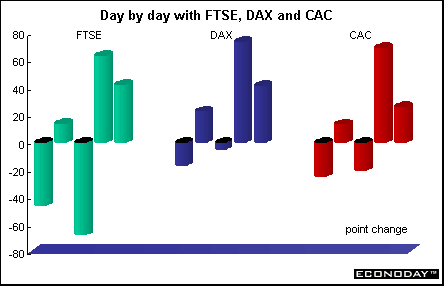
ECB carries through its threat to increase interest rates
As promised in mid-November by ECB President Jean Claude Trichet, the ECB increased its key interest rate by 25 basis points to 2.25 percent. This is the first change in rates for the ECB since June 2003 and the first increase in rates since October 2000. Eurozone rates had been held at an historic low of 2 percent since June 2003 against a backdrop of sluggish growth and high unemployment.
Most analysts agree that the 25-basis-point increase would not materially impact the fledgling European recovery despite the political uproar over the move. The move left the central bank at odds with EU finance ministers who lobbied hard against the increase. As to future rate increases, Trichet is on record as saying that, at this stage, he does not see the ECB following the Fed in initiating a series of interest rate increases. At his post-meeting press conference he said the decision to increase interest rates was warranted in order to adjust the ECB's accommodative monetary policy stance. Both pillars of monetary policy - the harmonized index of consumer prices and M3 money supply growth - are substantially above the ECB's targets. The HICP flash reading for November was 2.4 percent on the year while the most recent reading for the M3 three-month moving average was 8.2 percent on the year. The ECB's targets are below 2 percent for inflation and 4.5 percent for money supply growth. The ECB is mandated by treaty to focus on inflation as its primary goal. As part of his press conference statement, Trichet announced that the ECB had raised its 2006 HICP inflation and GDP growth projections. These estimates played a major role in the rate decision.
The bank's decision to act has stirred political controversy, especially in France and Italy, but Trichet took out some of the sting by making clear that the ECB would not be following the Fed by embarking on a series of rate increases. But Trichet must tread carefully. Higher interest rates mean a stronger currency, which in turn could hobble the exports crucial to economic recovery. Italy's current economic woes are due at least in part to its adoption of the euro, which deprived the government of the serial devaluations it once used to keep the country's labor-intensive manufacturing sector competitive on world markets.
Asia/Pacific
Japanese stocks have soared. The Nikkei has catapulted from 14,000 to over 15,400 in under a month and is up over 34 percent so far this year. The index closed at its highest level since October 16, 2000. The economy is growing thanks to strong exports and domestic consumption, and companies are forecasting an average 10 percent profit growth for this fiscal year (ending March 31, 2006). Overseas investors have bought a net ¥9,441 billion ($78.9 billion) of stocks so far this year according to the Tokyo Stock Exchange. Now they are seeing their returns eroded by the weakening yen. Corporate Japan, particularly on the domestic side, still needs to restructure. Exporters, meanwhile are enjoying robust demand and a weak yen, but still have to cope with climbing raw material costs.
In spite of many years of poor performance the Japanese stock market remains the world's second largest, and foreign investors are drawn to sectors that have undergone successful reform such as banking. But the strong interest shown by foreigners contrasts with the skepticism of Japanese institutional investors, who are still net sellers. For this reason, many in Japan regard this year's rally as very fragile. However, some analysts say that domestic institutions have already lost out by being too cautious. The stock market rally really took off in August, when economic indicators showed that domestic growth was accelerating and the Bank of Japan signaled that seven years of deflation were coming to an end. And Prime Minister Junichiro Koizumi's reelection guaranteed continued reforms and provided more impetus to investors.

Overall, Asian stocks are at their highest level in more than five years. Exporters such as Sony Corp. and Samsung Electronics led last week's advance after U.S. reports bolstered confidence that the world's largest economy is growing without generating inflation. On Friday, South Korea's Kospi index rose to a record for a third straight day. The index is up over 46 percent so far this year. Foreign car manufacturers have gained market share in the U.S. at the expense of GM and Ford.
Currencies
With the prospect of U.S. interest rates continuing to climb, the dollar gained against both the euro and the yen last week. The euro rose in the immediate aftermath of the ECB rate announcement Thursday, but quickly lost ground when it became apparent that this increase was not the first of many. With foreign exchange traders focused on interest rate differentials, interest in the euro quickly ebbed. The global hunt for yield has been a dominant factor with currencies backed by relatively high interest rates such as the U.S. and Australian dollars and sterling outperforming low yielding currencies such as the yen, euro and Swiss franc.
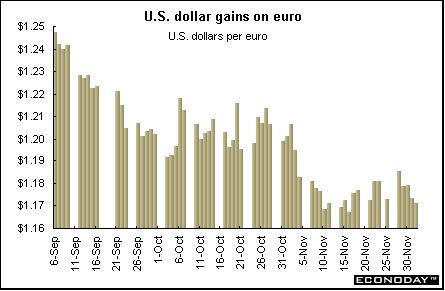
To the quiet delight of Japanese policymakers, the yen just keeps declining. A cheap yen boosts exports, still a key determinant of growth, and helps reflate the economy. But currency depreciation has done little to diminish foreigners' appetite for Japanese equities. Anecdotal evidence shows U.S. investors are starting to hedge their currency exposure. Meantime, Japanese investors are putting more cash to work overseas. Theoretically, capital outflows should diminish and the currency would strengthen when the Bank of Japan returns to normalized monetary policy possibly as soon as next year.
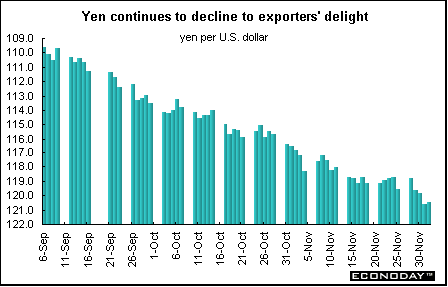
The ECB move could put increased pressure on the yen. Many investors attempt some version of carry trade - borrowing at low short-term rates and investing in higher-yielding assets. The dollar was once the base of the carry trade but is no longer because of increasingly higher U.S. rates and currency strength. The euro was a potential base for the trade but now with rates rising, the yen - where rates are still zero and the currency has been falling - is the much more obvious choice.
Indicator scoreboard
Below is a compendium of major economic releases for the past two weeks.
EMU - September merchandise trade surplus was €1.4 billion, a vast improvement over August's deficit of €2.2 billion. Exports were up 0.3 percent while imports were down 0.7 percent. The Eurozone's trade surplus narrowed on a year-on-year basis in September, European Union statistics office Eurostat said on Monday. Germany, followed by Ireland, Finland and Austria contributed to the surplus. Both the Netherlands and Spain ran deficits. The trade position with China showed a significant deterioration, with imports up 26 percent but exports up only 2 percent when compared with a year ago.

October M3 money supply was up 8 percent when compared with last year. For the three months ending in October, M3 was up 8.2 percent on the year. This is well above the ECB target growth rate of 4.5 percent.

Third quarter gross domestic product was up 0.6 percent and 1.6 percent when compared with last year. The largest contributors to growth were exports, up 3.4 percent on the quarter, and gross fixed capital formation, up 1.6 percent. Private consumption remained weak, edging up 0.3 percent after a 0.2 percent gain in the second quarter.

November flash harmonized index of consumer prices was up 2.4 percent when compared with last year. As with all flash reports, no details were available. The increase remains above the ECB's stated inflation target of no more than 2 percent.
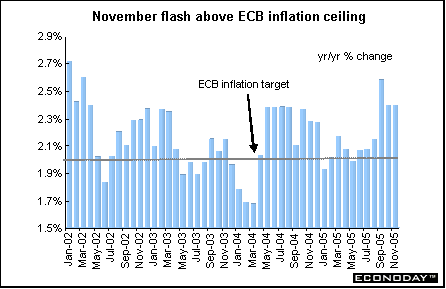
November manufacturing purchasing managers' index edged upward to 52.8 from 52.7 in October. The index slowed in Germany and France but improved in Italy and Spain. Both output and new orders growth accelerated. An index reading above the breakeven level of 50 indicates growth.

October unemployment rate remained at 8.3 percent for the second month. Unemployment was higher in Germany and Austria while it was lower in Spain and France. It should be noted that the method of calculation differs from the national jobless rates calculated for most countries including Germany and France.
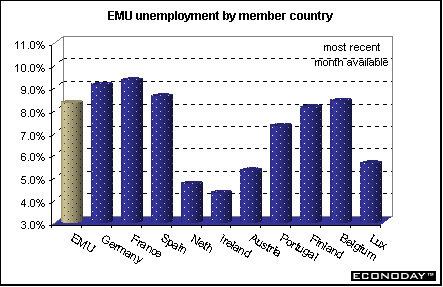
October producer price index jumped 0.6 percent and was up 4.1 percent when compared with last year. Excluding construction, the PPI was up 0.6 percent and 4.1 percent on the year. Excluding just energy, the PPI was up 0.3 percent and 1.3 percent on the year.
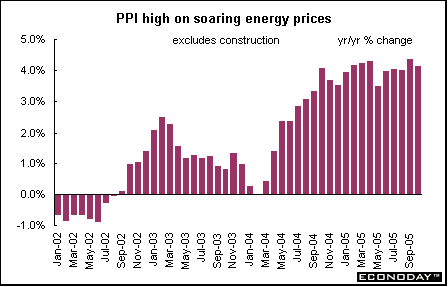
Germany - Third quarter real seasonally adjusted gross domestic product was up 0.6 percent and 1.4 percent when compared with the same quarter a year ago. Economic growth sped up on stronger exports, but is still getting little support from domestic demand. Exports were up 4.7 percent in stark contrast to domestic demand, which managed an increase of 0.3 percent on the quarter. Investment contributed to stronger third quarter growth. Machinery and equipment was up 3.8 percent after edging up just 0.6 percent in the second quarter.

November Ifo business sentiment survey declined to a reading of 97.8 from 98.8 in October. The decline was attributed to the longer-than-expected time that it took to resolve September's election results. The indexes for both current and future conditions were down. The Ifo surveys 7,000 manufacturing, construction, wholesaling and retailing firms for their assessment of current conditions and their expectations for six months from now.

November seasonally adjusted unemployment dropped by 53,000. Unemployment dropped 34,000 in the west and 19,000 in the east. The unemployment rate for all of Germany was 11.5 percent, down from 11.6 percent in October. The unemployment rate dropped to 18 percent from 18.3 percent in the east. The rate in the west declined to 9.7 percent from 9.9 percent. October employment was up by 15,000 jobs.

France - October consumer spending was down 0.6 percent but was up 1.8 percent when compared with last year. Auto sales were down 1 percent while spending on apparel and leather goods sank 3.1 percent. However spending was up 0.5 percent for white goods, big-ticket household electronics and furniture.
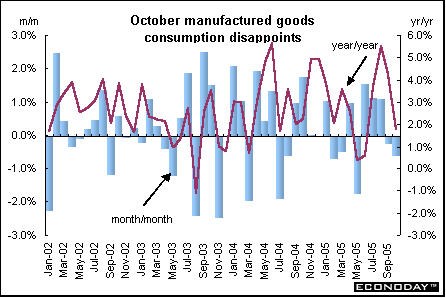
October seasonally adjusted unemployment rate edged down to 9.7 percent from 9.8 percent in the previous month. The number of jobless was down by 13,000. At the same time, registered job seekers declined by 21,700. The data are calculated using the International Labour Organisation definition which excludes job seekers who did any work during the month.
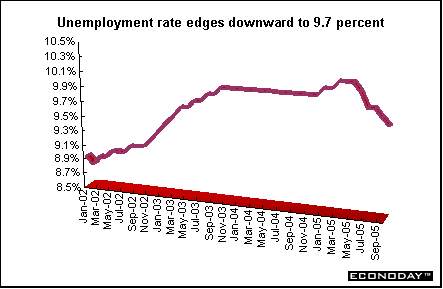
Britain - Third quarter gross domestic product was up 0.4 percent and 1.7 percent when compared with the same quarter a year ago. Household spending was up 0.5 percent and 1.6 percent on the year while government spending was up 0.3 percent and 1.6 percent. Investment climbed 1 percent and 2.8 percent on the year. Output growth was hampered by a large one-time 7.7 percent plunge in mining and quarrying due to maintenance work and other factors.
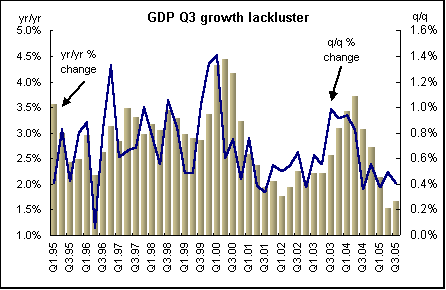
Asia
Japan - September tertiary index was down 0.7 percent but was up 2.3 percent when compared with last year. The tertiary index reflects activity in 11 service industries: utilities, transport, telecommunications, wholesale and retail, finance and insurance, real estate, restaurants and hotels, medical, health care and welfare.

September all industry index was down 0.4 percent but was up 2 percent when compared with last year. The all industry index takes a reading of activity in the industries that comprise the tertiary index combined with activity in the construction, agricultural and fisheries industries, the public sector and industrial output. This index is considered a close approximation for gross domestic product growth as measured by industrial and service sector output.
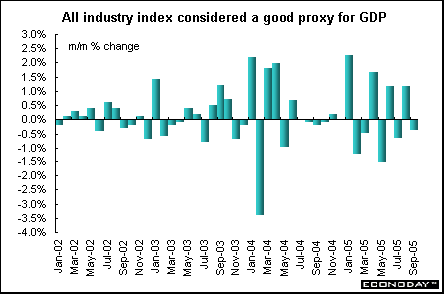
October spending by households headed by wage earners was up 1 percent and 1.6 percent when compared with last year. Wage-earner household spending is an important gauge of personal consumption, which accounts for roughly 55 percent of Japan's gross domestic product. The propensity for wage-earner households to consume, a ratio which measures the amount of disposable income that went to household spending, rose to 73.9 percent from 73.6 percent in September.

October unemployment rate jumped to 4.5 percent from 4.2 percent in September. The total number of jobless fell 70,000 on the year, marking the 29th straight month of declines. The economy lost 230,000 jobs, while the workforce shrank by 50,000 people.
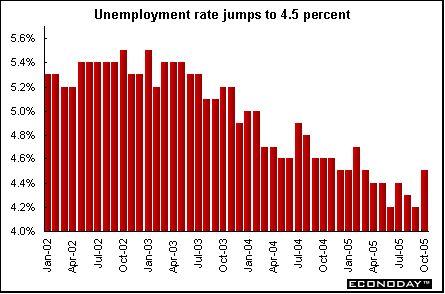
October industrial production was up 0.6 percent and 3 percent when compared with last year. Shipments were up 1.7 percent while inventories decreased 1.7 percent. The increase in production was attributed to higher exports.
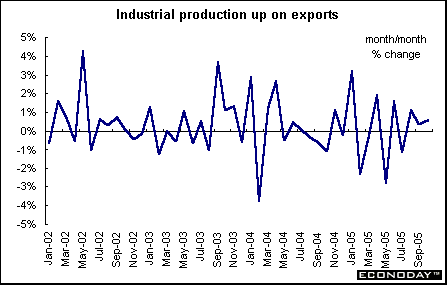
November Tokyo consumer price index was unchanged on the month and down 0.9 percent when compared with last year. Core CPI, which excludes fresh food, was down 0.2 percent and declined 0.3 percent on the year. October national CPI was up 0.1 percent but sank 0.7 percent on the year. National core CPI was up 0.1 percent and unchanged on the year.

October unadjusted merchandise trade surplus narrowed to ¥822.1 billion ($6.9 billion) as strong domestic demand caused imports to outpace exports. The 28.8 percent drop in the surplus from the same month a year ago was partly driven by a 49.5 percent increase in the value of oil imports. Exports were up by 8 percent while imports were up 17.8 percent on the year. On a seasonally adjusted basis, the trade surplus was ¥719.7 billion, up from ¥581.2 billion in September. Imports were up 1.4 percent while exports climbed by 3.7 percent on the month.
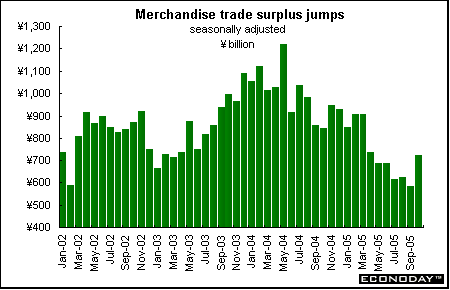
Americas
Canada - September retail sales were down 0.9 percent but up 5.5 percent when compared with last year. Auto purchases suffered their largest drop since 1998. Excluding cars, sales increased 1.7 percent during the month, the largest gain for non-auto retailers in eight months. Spending increased in 14 of the 19 retail categories. Sales at new car dealers fell 11 percent in September. Sales at furniture stores increased 2 percent in September. They rose 0.8 percent at electronics stores and 2.7 percent as clothing retailers.
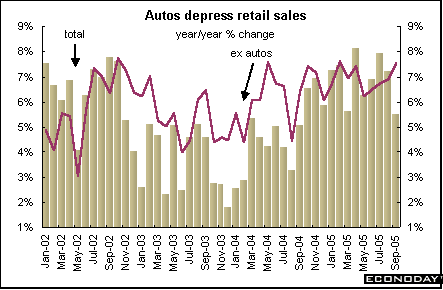
October consumer price index was down 0.5 percent but up 2.6 percent when compared with last year. The price of gasoline, which accounts for about 5 percent of the spending covered by the consumer price index, was down 8.9 percent but up 17 percent from a year earlier. Excluding food and energy prices the CPI was down 0.1 percent but up 1.5 percent from a year earlier. Excluding the eight most volatile items, as defined by the Bank of Canada, the "core" index in October was unchanged from September but up 1.7 percent from a year earlier.

October industrial product price index (IPPI) declined 0.1 percent but was up 1.4 percent when compared with last year. Lower prices for petroleum products were the major contributor to the monthly decrease. Petroleum and coal products prices decreased 3.2 percent, the first decrease in five months. If petroleum and coal product prices had been excluded, the IPPI would have increased 0.3 percent rather than decreasing 0.1 percent. The 12-month change was largely due to higher prices for petroleum products as well as chemical products. Prices for petroleum and coal products were up 24.6 percent on the year. If petroleum and coal product prices had been excluded, the IPPI would have decreased 0.8 percent rather than increasing 1.4 percent from a year ago.
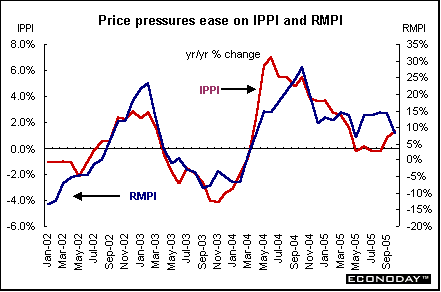
October raw materials price index (RMPI) was down 1.4 percent but was up 8.3 percent when compared with last year. Prices declined for mineral fuels and ferrous materials. Mineral fuels were down 4.0 percent on the month. Crude oil prices decreased 4.6 percent as inventories increased and demand was lower. Ferrous materials decreased 3.6 percent while iron and steel scrap prices were down 5.9 percent. On the year, mineral fuels were up 14.0 percent with crude oil prices rising 16.4 percent. If mineral fuels had been excluded, the RMPI would have increased 2.2 percent instead of increasing by 8.3 percent.
Since the value of the Canadian dollar against the US dollar was unchanged in October, the total IPPI excluding the effect of the exchange rate was also essentially unchanged. On a 12-month basis, the value of the Canadian dollar rose 5.9 percent against the U.S. dollar. If the impact of the exchange rate had been excluded, producer prices would have risen 2.9 percent on the year rather than their actual increase of 1.4 percent.
Third quarter gross domestic product was up 0.9 percent and 2.8 percent when compared with the same quarter a year ago. Final domestic demand equaled the 1 percent growth in the second quarter. Third quarter growth was affected by a very active energy sector which pushed up business investment, corporate profits as well as goods producing industry output and prices. Exports were up 2.5 percent.
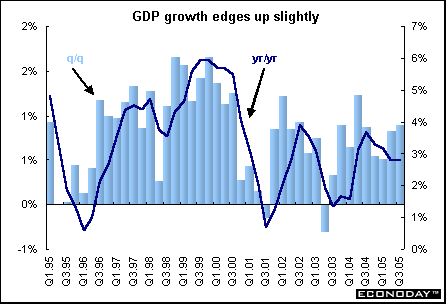
November employment was up 30,600 - full time jobs were up by 50,200 while part time jobs dropped by 19,600. The unemployment rate was 6.4 percent, down from 6.6 percent in October. Manufacturing jobs were up by 6,800. Service jobs were up by 24,400 despite declines in finance, insurance, real estate & leasing and health care sectors.
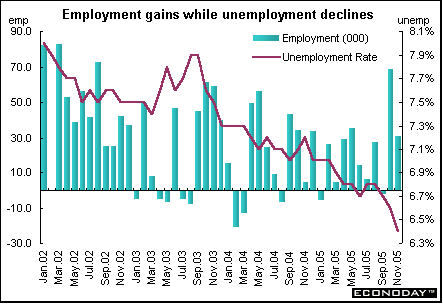
Bottom line
After all the attention that the ECB garnered last week when they increased their key rate, the central bank meetings this week will seem very benign. Only the Bank of Canada is expected to increase their key rate on Tuesday to 3.25 percent. The Reserve Bank of Australia and the Bank of England will also meet next week and are expected to leave their interest rates unchanged at 5.5 percent and 4.5 percent respectively.

